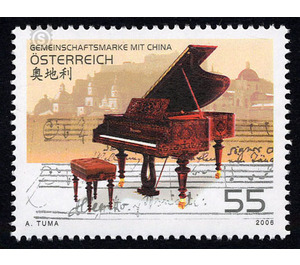Musical instruments - Austria / II. Republic of Austria 2006 - 55 Euro Cent
Theme: Art & Culture
| Country | Austria / II. Republic of Austria |
| Issue Date | 2006 |
| Face Value | 55.00 |
| Edition Issued | 600,000 |
| Printing Type | Photogravure |
| Stamp Type | Commemorative |
| Item Type | Stamp |
| Chronological Issue Number | 1953 |
| Chronological Chapter | OOS-OE2 |
| SID | 987490 |
| In 54 Wishlists | |
Every year, thousands of tourists from Asia come to Austria to experience our musical tradition at the highest level. The visit of concerts and operas is one of the fixed points of their stay. The joint issue of Austria - China, presented in traditional musical instruments, is all about this musical friendship. For Austria a piano of the worldwide known company Bösendorfer was selected. China presents the Guqin, pointing to a 3,000-year musical tradition. The special timbre and its technique, the so-called "Viennese Mechanics", make the Bösendorfer piano an instrument that enjoys international recognition. When the company founder Ignaz Bösendorfer received the concession as pianoforte master in 1828, this was the cornerstone of a tradition of Austrian piano production reaching into our century. Artisanal perfection and the highest quality in production characterized the products right from the start. Soon the music world became aware of the singing, carrying tone of its instruments. The young Franz Liszt, who had smashed every wing with his spirited technique, stood the Bösendorfer and inspired pianists as well as audience. The worldwide triumph of the wing began. Architects and artists such as Theophil Hansen, Hans Makart and Josef Hoffmann designed special wings for Bösendorfer. Many famous pianists, such as Wilhelm Backhaus, Paul Badura-Skoda or Oscar Peterson, appreciate the Bösendorfer sound and see the instrument as an ideal embodiment of "Viennese music culture". The reference to the Mozart Year 2006 is also clear on this mark. Against the background of the city of Salzburg, the piano stands on a sheet music from the original score of Mozart's "Le Nozze di Figaro", one of his most famous operas, which he composed in Vienna in 1785/86. Mozart proved with this opera political boldness - but was the literary model of "Figaro" the comedy "A great day" by Beaumarchais, whose performance was prohibited in France at that time. Beaumarchais denounced in it the transgressions of the nobility. The libretto by Lorenzo Da Ponte is not quite as revolutionary as the original, but it was always an affront to the nobility.


